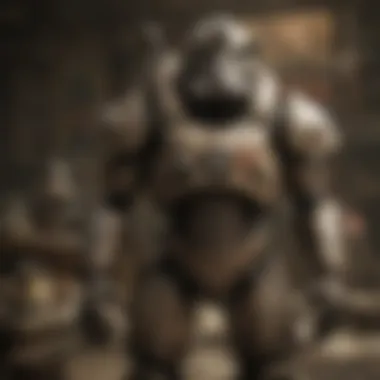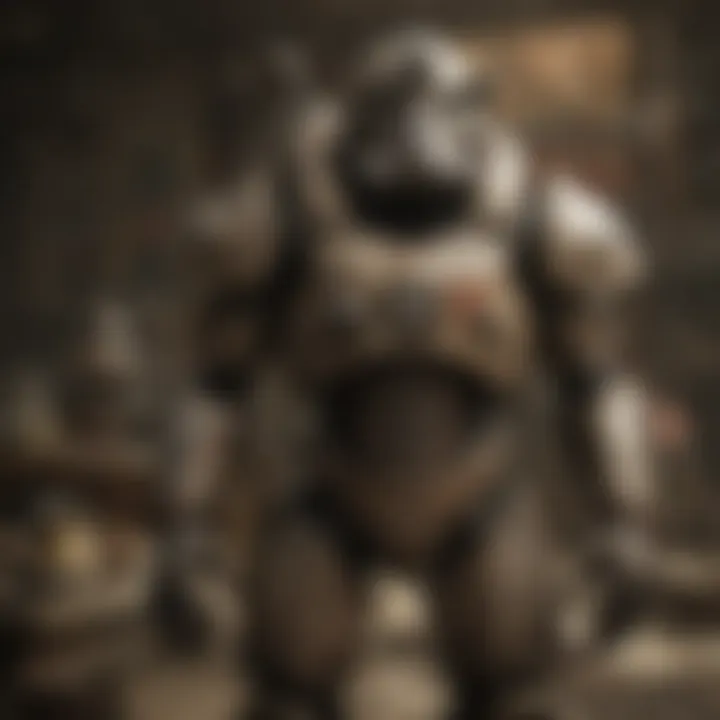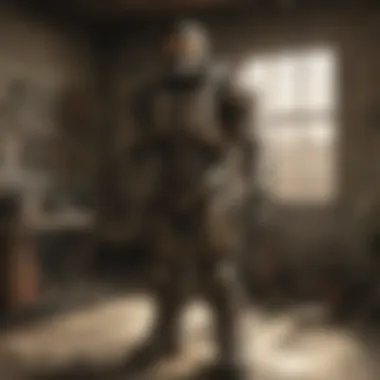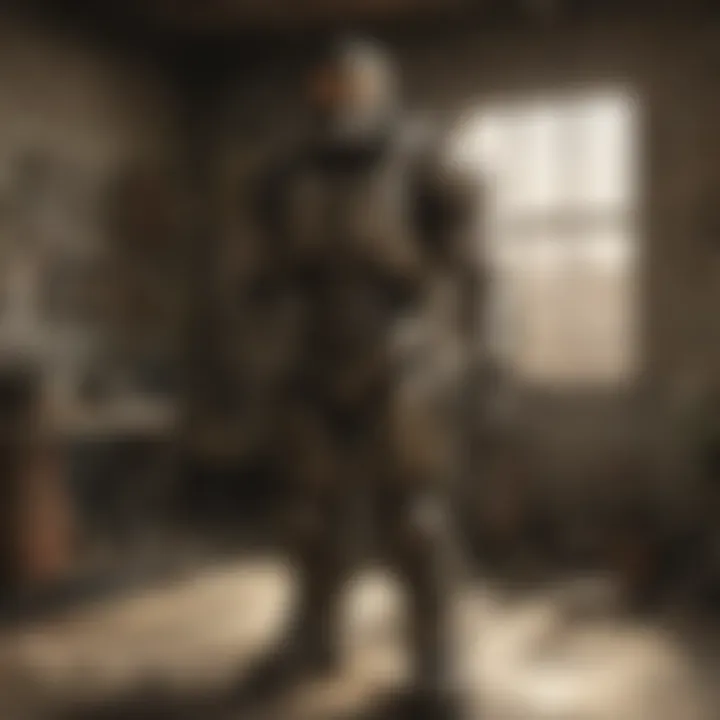Exploring Ceramic Artifacts in the Fallout Universe


Intro
The Fallout universe is expansive and rich, filled with unique items that showcase the remnants of civilization. Among these, ceramic items hold a special place, both in terms of aesthetics and functionality. Their presence is not merely decorative; they echo the past while serving practical purposes in a post-apocalyptic world. Understanding the significance of these artifacts provides valuable insight into the game's lore and player experience.
Ceramics in Fallout feature prominently in various aspects. Their history illustrates the cultural backdrop before the bombs fell. These artifacts have been found in many of the game's settings, from abandoned homes to remnants of once-thriving towns.
In this article, we will explore the world of ceramic items in Fallout, examining their historical context, gameplay applications, and their broader cultural implications. This look will help fans and players appreciate the depth of these artifacts in both lore and practicality.
Lore Insights
Overview of the Fallout Universe
The Fallout series is set in a divergent history where the Cold War escalated into global nuclear warfare. This timeline diverges from our reality around the 1950s, resulting in a unique fusion of retrofuturism and dystopia. The remnants of society are filled with stories, and ceramic items reflect the lifestyles of the people who made them.
Key historical events in the Fallout timeline
The events leading up to the Great War in 2077 shape much of what players experience. Some ceramic items found in-game date back to this era, telling stories of families, communities, and everyday life. Recognizing these historical pieces reveals the contrasts between pre-war life and post-apocalyptic survival.
Deep dive into the backstory of major factions and characters
Ceramic items also resonate with the various factions present in Fallout such as the Brotherhood of Steel and the Institute. Each faction's connection to these artifacts can be seen in the way they value technology versus tradition. For example, certain ceramics could signify resourcefulness among those in the wasteland, embodying survival strategies adopted by different groups.
"Ceramics, though seemingly mundane, tell the stories of those who lived before the bombs fell, bridging the gap between history and gameplay."
Gameplay Tips and Strategies
Beginner's guide to playing Fallout games
For newcomers, understanding the role of items, including ceramics, is crucial. Ceramics can be used in crafting, allowing players to create useful objects and aids in gameplay. This makes collecting these items essential for survival in the wasteland.
Weapon and armor recommendations
While ceramics themselves may not be weapons, they are integral to crafting better defenses and tools. Knowing which items to prioritize helps in creating stronger characters. Consider items like the Combat Armor and how ceramics contribute to materials needed for enhancements.
Tips for efficient resource management
Utilizing ceramic items effectively contributes to resource management. Players should collect them where possible. This practice not only assists in crafting but also allows for barter with other NPCs, providing the player with necessary resources to sustain their journey.
Character Analysis
Detailed profiles of iconic characters
Key characters in Fallout often have backstories intertwined with the items and lore of the world. Understanding their connections to ceramic artifacts helps deepen appreciation for their narratives. For instance, characters may reference items with sentimental value that highlight their personal histories.
Relationships between characters in the Fallout series
Character relationships are also affected by collecting and exchanging ceramic items. These interactions can reveal motivations and conflicts, enriching the player's understanding of the intricate web of connections throughout the series.
Character development and evolution across games
As players progress through the series, the evolution of characters often aligns with the items they prioritize. The value placed on ceramic items can serve as an indicator of their growth or decline in the harsh environment of the wasteland.
News and Updates
Latest announcements from game developers
Game developers continually release news regarding updates, including changes to item usage. Keeping up with these announcements is vital for understanding how ceramics may be integrated into future gameplay.
Patch notes and upcoming releases
Patch notes also delve into adjustments that may affect items players rely on. Upcoming downloadable content (DLC) might introduce new ceramic items with unique properties, expanding their role in gameplay.
Community events and tournaments
Community engagement often focuses on how players interact with the ceramic items. Tournaments frequently highlight strategies involving these artifacts, providing an avenue for fans to share their experiences.
Fan Theories and Speculations
Popular fan theories about the Fallout universe
Fans often speculate on the implications of ceramic items within Fallout's lore. Some theories suggest that certain ceramics may hold hidden messages or connections to the larger narrative, allowing players to engage more deeply with their gameplay experience.


Discussion on unresolved plot points
Many unresolved plot points in the series can be better understood through the context of ceramic items. These artifacts serve as tangible links to the stories and mysteries of the Fallout universe.
Predictions for future installments in the series
Looking ahead, players can anticipate how ceramics might evolve as the series continues. Speculations around their use in crafting or storytelling will be a point of interest for longtime fans of the franchise.
Understanding the role of ceramic items is fundamental for fans of Fallout. They provide insight into the narrative and enhance the player experience, all while serving as reminders of a world that once was.
Preface to Ceramic Items in Fallout
Ceramic items play a unique role in the Fallout universe, which extends beyond their visual appeal. Their presence not only enriches the game's aesthetic but also serves a practical function in both gameplay and lore. Introduction of ceramics within this gaming environment demonstrates how everyday objects can gain significance when recontextualized in a post-apocalyptic world. This aspect underlines the importance of exploring ceramic items, as they encapsulate a blend of history, utility, and artistry.
Understanding ceramic items further allows players to appreciate the depth of the Fallout universe. By delving deeper into the definition and historical context, players can see how these artifacts contribute to the immersive experience that Fallout provides. In essence, ceramic items act as a bridge between the past and the imagined future, grounding the narrative in tangible relics that reflect both cultural heritage and resourcefulness of survivors.
Definition of Ceramic Items
Ceramic items refer to objects created from clay and other inorganic materials, which have been shaped and fired to achieve a hard, durable finish. This category includes a wide range of products, from everyday dishes to ornamental vases, as well as utilitarian objects like ceramic tiles. In Fallout, these pieces are not just remnants of a destroyed civilization but serve various purposes that align with game mechanics and storytelling.
The definition of ceramics is critical because it emphasizes their functionality and emotional resonance within the game. Players can find ceramics scattered throughout different locales, reflecting the remnants of a society that once thrived.
Historical Significance in Real World
The historical significance of ceramics in the real world is both vast and complex. Pottery dates back thousands of years, providing insights into the daily lives and cultures of ancient civilizations. Different regions have distinct styles and techniques, highlighting regional identities and technological advancements.
Similarly, in the Fallout games, ceramics symbolize what was lost during the cataclysm. Their survival in a wasteland is a stark reminder of human ingenuity and cultural expression. As players navigate through the Fallout universe, they encounter various ceramic artifacts. These items evoke a sense of nostalgia for a time before the world was irrevocably altered. They emphasize the importance of craftsmanship and tradition, which starkly contrast against the backdrop of desolation and decay that defines the post-apocalyptic landscape.
Role of Ceramics in Fallout Lore
Ceramics play a vital role in the narrative framework of the Fallout universe. They serve not just as functional items but also as cultural artifacts reflecting society's values and historical context. Ceramics within the game signify the juxtaposition of everyday life before and after the nuclear fallout, emphasizing the normality of pre-war society compared to the chaos of the post-apocalyptic world.
Cultural Relevance
Ceramics are more than mere objects; they embody cultural narratives that enrich the lore of Fallout. In the game, fragile ceramic pieces often showcase intricate designs that hint at the artistic sensibilities of the bygone era. Items such as plates, vases, and figurines serve as remnants of human ingenuity and creativity. These objects symbolize a connection to lost heritage, allowing players to grasp the human experience in a time when society was intact.
The presence of these artifacts in the ruins of dilapidated houses and abandoned stores demonstrates a lingering essence of culture. Players come across them while scavenging, encountering poignant reminders of what once was. This layering of reality adds depth to the gameplay experience, inviting reflection on the impact of human actions on culture and the environment. The storytelling potential of these ceramics engages players as they explore the history inscribed in these objects.
"Ceramics offer a glimpse into the past, revealing the beauty and fragility of what has been lost."
Ceramics in Pre-war Society
In pre-war society, ceramics held significant utilitarian and artistic value. Everyday ceramic items like dishes and mugs were staples within households, widely used by families across various social classes. Beyond basic functionality, these objects often reflected personal identity and social status. Decorative pieces adorned homes and were often gifted during special occasions, marking important social interactions.
The production of ceramics relied heavily on craftsmanship and tradition. Various styles emerged depending on region and cultural influences, showcasing a rich diversity within the ceramic arts. Whether made for everyday use or decorative purposes, these items played an integral role in daily life. Additionally, the use of vibrant glazes and unique designs highlighted the skill of artisans who created them.
Thus, ceramics form a critical aspect of cultural memory. They tell stories of human connection, daily routines, and communal values. In the Fallout universe, these qualities stand in stark contrast to the desolation after the war. The stark representations of ceramics in the game serve as poignant reminders of a society that once thrived, adding layers of meaning to the player's journey through this rich narrative landscape.
Types of Ceramic Items Found in Fallout
In the expansive universe of Fallout, ceramic items serve both practical and narrative purposes. These artifacts emphasize the remnants of a world long gone, encapsulating the ingenuity of pre-war society. The ceramic pieces discovered throughout the wasteland can vary widely in function and aesthetic appeal. This section dives into the different types of ceramic items found in the game, allowing players to appreciate both their utility and their historical context.
Everyday Household Items
Household ceramic items reflect the mundane aspects of life before the Great War. Items such as plates, cups, and pots are often found within abandoned homes and looted structures. These pieces are not just decoration; they play a crucial role in the game’s crafting and survival mechanics. Players can collect these items to use as crafting materials, enhancing their resource management strategy.
For instance, ceramic bowls can be combined with other materials to create simple yet essential survival tools. The presence of these items, while often overlooked, grounds the player’s experience in a reality that feels familiar yet altered. Players often report that collecting these items provides a nostalgic feeling, connecting them to the lore and history of Fallout’s universe.
Decorative Ceramics
Decorative ceramics add a layer of cultural depth to the world. These are not merely functional items; they also include artistic expressions of pre-war society. Vases, figurines, and intricately designed plates represent the aesthetic values and craftsmanship of the time. These pieces often vary by region, showcasing unique designs influenced by local cultures.
Finding and collecting decorative ceramics can become a rewarding aspect of gameplay. Players may choose to display these items in their settlements, creating a personal touch that reflects their journey through the wasteland. Thus, these ceramics go beyond mere practicality, enhancing the narrative and allowing players to build a sense of identity within the game.
Ceramic Weapons and Armor
The practical applications of ceramics extend to weapons and armor as well. In the Fallout universe, some weapons utilize ceramic materials for their durability and lightweight properties. Items like ceramic knives or even shield-like armor pieces serve a dual purpose of protection and offensive capability. These weapons often appeal to players who prioritize agility in combat while maintaining a solid defense.
Moreover, the ability to craft and upgrade these items based on ceramics results in a deeper engagement with the game mechanics. Ceramic weaponry is not just a choice of equipment; it indicates a player’s adaptability and understanding of what can be salvaged from the environment. This dynamic enhances both the gameplay experience and the character’s development within the narrative.
"The ceramics of Fallout not only serve as reminders of a bygone era but also enrich the player’s interaction within the game, offering both utility and aesthetic satisfaction."


Gameplay Mechanics Involving Ceramics
Ceramics play an important role in the gameplay of the Fallout series. They serve as a multifaceted element that enhances both the experience and the functionality of various game systems. Through crafting, repair, and inventory management, players interact with ceramic items in ways that influence their survival and strategies in the wasteland.
Crafting and Repair Systems
In Fallout, the crafting system allows players to create and improve weapons, armor, and various other items. Ceramics are often used as materials in this process. Players discover different ceramic items scattered throughout the game world. These can then be salvaged to produce valuable resources.
The flexibility of ceramics means they serve multiple purposes in crafting. For example, items like ceramic plates or mugs can be broken down into components. These components might include ceramics used for weapon enhancements or protective gear.
Additionally, the repair system relies heavily on ceramic items. Players can return to workbenches to restore their equipment. Ceramics become vital when players need to fix damaged items. This enhances the economic aspect of gameplay, as players must make decisions on what to repair or create based on the materials at hand.
Inventory Management
Efficient inventory management is critical in Fallout. Each item has a weight that affects how much a character can carry. Ceramic items vary in weight, but they often pack a good value-to-weight ratio. This means players must carefully consider which ceramics to keep and which to discard.
By managing their inventory wisely, players can maximize their effectiveness in combat or exploration. For instance, carrying lightweight ceramics might allow players to transport more important items, like weapons or food.
Moreover, some ceramics can be classified as scrap. Recognizing the difference between usable items and junk can ease the burden of inventory overload. This aspect of gameplay encourages players to explore and gather as many ceramic pieces as they can for future crafting or trading.
"Creative inventory management allows players to thrive in the harsh environments of Fallout, turning simple items into lifelines."
Collecting Ceramic Items
Collecting ceramic items in Fallout is not just a hobby for players; it serves as a window into the game’s rich lore and history. Each piece has a story, reflecting the world that once was before the nuclear cataclysm altered everything. The pursuit of these artifacts transforms mundane exploration into a quest for knowledge, understanding, and sometimes even nostalgia. Moreover, ceramic items enhance gameplay through crafting, bartering, and character customization.
Finding Rare Pieces
Finding rare ceramic items can be one of the most exhilarating aspects of gameplay. These pieces are often scattered throughout the various post-apocalyptic landscapes and can require thorough searching. Here are some places where players might locate these hidden gems:
- Abandoned Homes: Many ceramic items can be found in homes that have been untouched since the Great War. Such locations may hold decorations or tableware steeped in history.
- Trading Posts and Markets: Some NPC traders may offer unique ceramic items. Engaging with these characters can lead to discovering rare pieces that other players may overlook.
- Quests: Certain missions might reward players with special ceramic items upon completion. Completing these can additionally enrich the player's inventory and enhance their collection.
"Exploration rewards you with more than just items; it offers a glimpse into the people's lives before the atom bomb fell."
To ensure a successful hunt, players should also improve their perception skills. Higher levels often reveal hidden locations and increase the chances of spotting collectible items.
Adding to Player's Collection
Once players find rare ceramic pieces, the next step is incorporating them into their collection. This act of collecting serves several purposes. First, it allows players to appreciate the visual aesthetics of the items. Second, it opens up opportunities for in-game crafting and customization.
Players may consider the following when adding to their collections:
- Showcases and Displays: Setting up a display area in their settlements can personalize and enhance the aesthetic appeal of their chosen space.
- Bartering Opportunities: Some ceramic items can be used as trade commodities. This not only aids in building wealth but also enriches the interaction with NPCs and other players.
- Completionist Goals: Some players aim to collect every type of ceramic item available in the game, challenging them to explore every nook and cranny of the Fallout universe.
In summary, ceramic item collecting in Fallout is more than a pastime; it embodies a multifaceted interaction with the game’s world, enhances player experience, and opens avenues for creative expression through collection and display.
Ceramics and Player Interaction
Ceramic items in the Fallout universe serve not only as relics of a bygone era but also play a crucial role in player interaction within the game. These items add depth to the gameplay experience through trade, barter systems, and their impact on player reputation. By understanding these interactions, players can better navigate the complexities of the in-game economy and social dynamics.
Trade and Barter Systems
Trading ceramic items in Fallout is more than a simple transaction; it is a strategic aspect of gameplay. Players can collect various ceramic pieces, ranging from common dishes to unique artifacts. These items can serve as valuable currency when engaging with non-player characters (NPCs) or other players.
- Value in Trading: The rarity and condition of ceramic items directly influence their trade value. Common items may not fetch much, while rare or well-preserved pieces can lead to favorable trades.
- Strategic Bartering: Players might use ceramics to acquire essential supplies, weapons, or information. Negotiating with NPCs often requires an understanding of what items hold greater value.
- Learning the Market: Prices can fluctuate based on the player’s reputation and the NPC’s disposition. Understanding these dynamics can make trading more advantageous.
This trading system encourages players to explore the wasteland for ceramic items, enhancing their gameplay experience. While some players might focus solely on combat, the inclusion of trade and barter introduces a layer of immersion and strategy that enriches the overall narrative.
Impact on Player Reputation
Ceramics also impact player reputation within the Fallout universe. The way players interact with these items can influence how NPCs perceive them.
- Positive Contributions: Players who collect and trade ceramics responsibly may earn goodwill among factions or NPCs. This can lead to discounts, exclusive items, or even new quests that enrich the story.
- Neglecting Ceramics: On the other hand, a player who hoards or misuses these items may develop a negative reputation. NPCs might refuse to trade, which ultimately limits resources available to the player.
- Dynamic Relationships: Reputation is not static; it changes with each interaction. Engaging positively with ceramic items allows players to build softer connections in a world fraught with conflict.
"Ceramics are a tangible reminder in the Fallout world of past human craftsmanship, and interacting with them in trade reflects the remnants of civilization and its values."
Overall, the trade and impact of ceramic items on player reputation intertwine to create a more engaging and interactive experience. Understanding how to navigate these elements is paramount for players seeking to thrive in the Fallout universe.
Environmental Considerations
In the expansive narrative of the Fallout universe, ceramic items play an important role beyond their aesthetic and functional attributes. Analyzing environmental considerations helps us underscore their significance in the game's world. The post-apocalyptic landscape is characterized by scarcity and resourcefulness, particularly regarding materials. Ceramics, often made from clay and minerals, highlight sustainability themes that resonate with a knowledgeable audience. Understanding these aspects can offer a deeper appreciation of the game's mechanics and underlying messages.
Sustainability of Materials
Ceramic materials derive from natural resources, primarily clay and silica. In the Fallout context, this ties into the broader theme of environmental sustainability. Using ceramics promotes a circular economy model, where resources are reused and repurposed, reflecting the remnants of pre-war society. Players encounter this aspect as they scavenge the wastelands, collecting ceramic items that embody the skills of previous inhabitants.


The significance of sustainability manifests in the crafting systems within the game. For example, players may find fragments of ceramic plates or pots while exploring ruined homes. These materials can often be repurposed for creating functional items or aesthetic decorations in their camps. This interaction engenders a sense of stewardship towards their environment, urging players to think about resource conservation.
Recycling and Upcycling in Gameplay
The gameplay mechanics in Fallout also embrace recycling and upcycling, highlighting how players can transform found ceramic items into valuable resources. When players collect these ceramics, they often possess options to break them down into raw materials that can then be used for crafting. This cycle of use and reuse emphasizes the importance of minimizing waste, a crucial element in real-world environmental discussions.
Additionally, players may combine broken ceramic pieces to create unique designs or upgraded versions, enhancing their inventory's aesthetic and utility. The incorporation of upcycling into the gameplay experience fosters creativity. Players become artisans, leveraging their findings to adapt to the harsh realities of the wasteland.
"In an environment where resources are meager, the ability to recycle materials becomes not just a gameplay mechanic but also a philosophical stance on survival and ingenuity."
Through these interactions, players gain an appreciation for the value of ceramics—not merely as relics of a bygone era but as integral components that drive gameplay and enrich the player's journey. The environmental considerations surrounding ceramics in Fallout reflect broader themes of resilience and sustainability that resonate with both the narrative and the players' experience.
Ceramics in Fallout Spin-offs
Ceramics as a theme in the Fallout universe extend beyond the main series, finding relevance in various spin-off titles. This significance is not merely decorative but deeply rooted in gameplay mechanics and world-building. The elements of ceramics in these titles reinforce the overarching themes of survival and resourcefulness that permeate the Fallout franchise. They also highlight the adaptability of community and culture in the post-apocalyptic world.
Exploration in Additional Titles
Within the spin-off titles, such as Fallout Tactics and Fallout Shelter, ceramics are often represented in a more utilitarian manner. In Fallout Tactics, ceramic items might take the form of essential tools or materials necessary for crafting and combat enhancement. This aspect emphasizes how survivors in the wasteland rely on the remnants of the past to forge their future. The items found often echo the aesthetics of pre-war society, echoing history in a more abstract way.
In Fallout Shelter, the ceramic pieces can be noticed as part of the environment within the vaults. Items seen in dwellings reflect an effort towards normalcy in a chaotic world. Players can find ceramic coffee mugs or plates that serve not just as collectibles but also contribute to the ambiance, solidifying the idea that even in survival, there remains a desire for comfort and beauty.
Connections to Main Series
The exploration of ceramics in spin-off titles often creates a bridge back to the main series, connecting the lore and themes consistently throughout the franchise. For instance, items like the ceramic dinner plates in Fallout 3 highlight the continuity of cultural symbols across different formats. These references serve to enrich the player's experience, as they see familiar elements being reused and reinterpreted in new contexts.
In several cases, ceramic items in spin-offs provide background details that enhance the world within the original games. They may appear in lore, influencing narrative arcs and character development. This interconnectedness illustrates the franchise's commitment to creating a cohesive and immersive universe.
The Aesthetic of Ceramic Design
In the Fallout universe, ceramic design is not merely a background detail; it represents a crucial aspect of the overall game aesthetic. The way ceramic items are crafted and presented contributes significantly to the game's immersive experience. Ceramic pieces serve as tangible links to a past civilization, instilling a sense of history and continuity in an otherwise fragmented world.
Visual Elements in Fallout
Visual design within the Fallout franchise is rich and varied. Ceramic items often embody this complexity through their textures, shapes, and colors. From the classic American diner mugs to ornate plates that might be used for decoration, the visual elements of ceramic items resonate deeply with the themes of nostalgia and decay. Players often find themselves attracted to how these ceramics reflect the cultural identity of the pre-war era.
The colors associated with ceramics—muted tones and occasional vibrancy—are emblematic of a world that once thrived. These colors are used to symbolize wealth and everyday life before the collapse of civilization. The contrast between the pristine nature of these items and the chaotic environment reinforces the dichotomy of the Fallout world, where beauty and destruction coexist. As such, ceramic items become avenues for storytelling within the game, each piece telling a unique tale of the life that once was.
Influence on Game Art Style
The game art style in Fallout draws heavily upon the concept of retro-futurism, blending elements of old-world aesthetics with imaginative depictions of technology. Ceramics play a crucial role in this blend, serving as reminders of a bygone era while complementing the game's overall artistic vision. The design of ceramic items captures that juxtaposition well, serving as both a nod to historical craftsmanship and a vital component of the game’s unique stylistic choices.
Items like ceramic figurines or dinnerware not only fit into the aesthetic but also enhance the immersive feeling of exploring the wasteland. When players encounter these items, they are not just collecting loot; they are engaging with artifacts that enrich their understanding of the game's world.
"Ceramic items reflect a world lost, yet their beauty and craftsmanship remain a poignant testament to human creativity."
Understanding the aesthetic qualities of ceramic items can deepen the player's appreciation of the Fallout series, highlighting how art and design contribute to storytelling in video games.
Ceramics and Community Engagement
Ceramics play a significant role in fostering community engagement within the Fallout universe. The inclusion of ceramic items not only enriches the game’s narrative but also invites players to connect on different levels. From fan projects to forum discussions, ceramics serve as a conduit for creativity and collaboration among fans.
Fan Creations and Costumes
The artistic expression of fans is often seen through their creations, specifically in relation to ceramics. Players frequently replicate ceramic items from the game in real life, showcasing their skills through pottery, 3D printing, and painting. Some fans have gone further, creating intricate costumes that emulate the look of iconic ceramic items. This connection deepens engagement, giving players a sense of pride and ownership of their hobby.
For instance, costuming conventions often feature Fallout-themed costumes that incorporate elements inspired by ceramic designs. Participants invest significant time to ensure accuracy, from the paint colors to the shapes of the items. This fosters a deeper appreciation for the aesthetic and historical context of ceramics in the game, creating a dedicated appreciation community.
"It's amazing to see how much effort fans put into recreating ceramic pieces from Fallout. It shows their dedication and love for the game."
Discussion in Forums
Aside from creative manifestations, forums serve as a vital platform where discussions about ceramics within Fallout thrive. Here, players exchange insights on where to locate ceramic items in gameplay, share crafting tips, or debate the implications of specific designs in the game’s lore. These conversations contribute to a collective understanding of how ceramics impact the overall experience.
Forums like Reddit feature threads specifically dedicated to ceramic items, where users post queries and offer solutions related to collecting and utilizing these artifacts in-game. Engaging in these discussions not only enhances individuals' gameplay strategies but also fosters a sense of community.
End
The exploration of ceramic items in Fallout underscores their substantial role in both gameplay and lore. This article has highlighted various aspects that contribute to their significance, examining how ceramics are not mere artifacts but essential components of the game's post-apocalyptic narrative.
Summary of Key Points
- Cultural Relevance: Ceramics reflect the social structures and cultural values of the pre-war society, offering insights into the world before the Great War.
- Gameplay Mechanics: The functionality of ceramics as crafting materials and their role in trade systems enrich the player experience, providing opportunities for customization and resource management.
- Aesthetic Importance: The design and style of ceramic items contribute to the visual identity of the game, enhancing immersion through their unique artistic expressions.
- Community Engagement: Fan interactions demonstrate how ceramics inspire creativity, from in-game collections to real-world replicas and discussions across platforms like Reddit and Facebook.
The Future Role of Ceramics in Fallout
Looking ahead, it is likely that ceramics will continue to evolve within the Fallout franchise. Future titles may expand on the historical significance of ceramic items, possibly introducing new gameplay elements that utilize these objects in innovative ways. The potential for deeper lore connections could enhance player engagement, inviting even more exploration around these artifacts. Furthermore, developers might integrate sustainability themes, examining how ceramics can be recycled or upcycled in the game's harsh environments. As players anticipate new adventures in Fallout, it becomes clear that ceramic items will remain a vital part of the ecosystem, paralleling real-world connections to history, art, and community.







